Brief User’s Guide
Kinesis
® Advantage™
USB Contoured Keyboard
(Mac/PC Switchable)
*KB500USB, KB500USB/QD, KB510USB
This document is designed to be a quick overview and refer-
ence guide for your new Advantage keyboard. The full User’s
Manual is available to download at http://www.kinesis.com/
support/manuals.htm.
Connecting to your computer
The Kinesis Advantage keyboard requires an available USB
port. For Macintosh systems, the operating system must be OS
8.6 or more recent. For Windows PCs, the operating system
must be Windows 98 or newer. No special driver is required;
just use the standard driver provided by the operating system.
The first time you connect your keyboard to a Windows PC,
the system will identify the keyboard as a new USB device and
should install generic “HID” drivers provided by the operating
system. It is advisable not to connect a USB device to the back
of the keyboard until the keyboard itself is installed and oper-
ating correctly.
Using integrated palm rests and palm pads
The palm rests are designed to provide comfortable support for
your hands while not actively typing, though many users rest
their palms some of the time while typing in order to relieve
strain on the neck and shoulders. For maximum speed, try
holding your palms slightly above the palm rest area while
typing. Do not expect to reach all of the keys on the keyboard
without moving your hands from a stationary position on the
palm rests. For maximum comfort, install the self-adhesive
palm pads provided with your new keyboard. Replacement
palm pads are available from your dealer or direct from Kine-
sis.
Familiar key layout (QWERTY standard, Dvorak dual-
legended available)
Kinesis Contoured keyboards retain the familiar QWERTY
key layout. Several changes in the location of non-letter keys
reduce the work required of your little fingers and increase the
workload for your stronger thumbs. Optional foot switches can
further reduce the work demanded of your hands and fingers.
Alphanumeric keys on the Advantage keyboard
The alphanumeric key layout is split into two separate sections
on the keyboard. However, the finger you use to press each
key is the same one that you would use on a traditional key-
board. The middle row of keys is the home row. To help you
to locate the home row, these keys are a different color and are
differently sculpted. It is also important to be able to find the
home row by touch from anywhere on the keyboard. To assist
with this, Kinesis has designed the tops of the home row keys
(i.e., the keycaps) with a cupped shape to fit your fingertips.
Keys which differ for PC and Macintosh
PC/
Windows keyboards and Macintosh keyboards have differ-
ent legends for certain keys that perform the same action. As
the contoured keyboard is both a PC and Mac keyboard, we’ve
provided a list below to clarify the slight differences you may
notice.
PC Backspace is the Mac “Forward Delete ”
PC Enter is the Mac Return
PC Ctrl is the Mac Control
PC Alt is the Mac Alt/Option
PC Windows key is the Mac Command key
Configuring your keyboard for PC or Mac with the
“instant configuration” feature
The Advantage USB MPC keyboard has three pre-configured
layouts, each optimized for different operating systems (see
following page): Windows, PC (non-windows), and Macintosh.
The keyboard is shipped in the Windows configuration.
To change to PC configuration (no Windows key), hold the =
key (above Tab) and tap the letter p. To change to Macintosh
configuration, hold the = key and tap the letter m. To change
back to the Windows configuration, hold = and tap the letter w.
See the three images below showing the thumb keys for the
different configurations.
Two extra keycaps and a keycap removal tool are provided
with your new keyboard if you decide to change from the Win-
dows configuration. For replacing selected keycaps, refer to
the diagrams on the following page.
*Three models are available.
KB500USB: standard model, QWERTY legends, available in
white or black.
KB500USB/QD: The Dvorak layout is a driverless on-board
feature of all Advantage keyboards. However, this model
has QWERTY/Dvorak dual legends on the keys (black only).
KB510USB: Advantage Pro has QWERTY legends, black
with metallic top finish, extra and lockable memory, and in-
cludes a foot pedal (see page 3 for memory locking details).
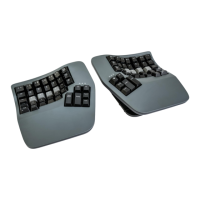
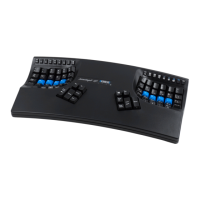
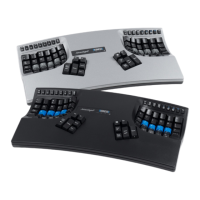
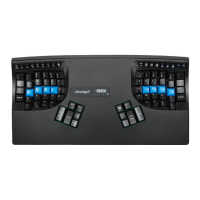
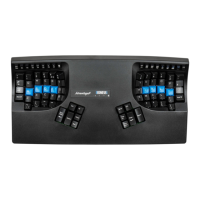
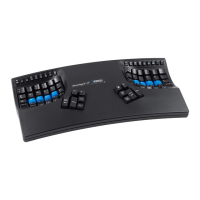
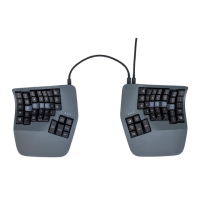
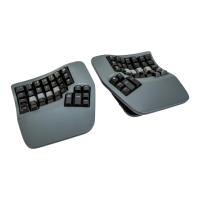
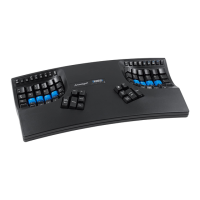
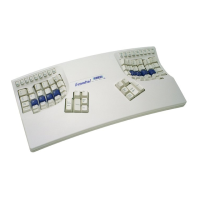
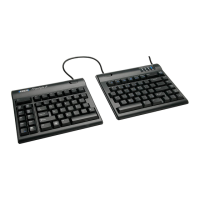
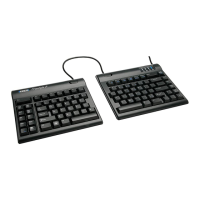
